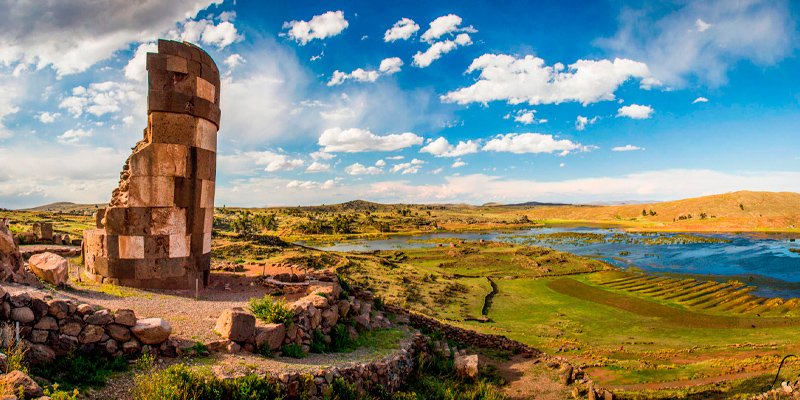
Tiahuanaco Tour from Puno 1 day -Puerta del Sol & Bolivia
Summary
Tiahuanaco from Puno 1 day
It is located 20 km south of Lake Titicaca in the territory of Bolivia, was the capital of the Tiahuanaco culture, a beautiful archaeological complex where there are remains of the building known as Kalasasaya and other important buildings such as: Puma Punku, the Sun Gate, Ponce Monolith, Keri Cala, Putuni, Laka Kollu; and the pyramids Akapana, and Wila Pukara, which served as a residence for the priestly elite, Tiahuanacu Tour from Puno.
In Tiahuanacu Tour from Puno we will see that many architectural constructions have not been preserved due to the low resistance of adobe against such severe weather conditions in the altiplano region.
Itinerary
Tiahuanaco from Puno 1 day
Itinerary
[day num=”1″]
Day 1
The tour starts with the pick up from the hotel in Puno at 08:00 am, to go by tourist transport for about 2 hours to the town of Tiwanaku.Tiahuanaco from Puno 1 day
Itinerary.
The first visit will be to the Lithic and Ceramic Museum where you will find archaeological pieces of the Tiwanaku culture.
Then we will visit the archaeological complex of Tiwanaku (kalasasaya temple, sun gate, semi subway temple, pyramid of akapana and pumapunku) all this tour has a duration of 2 hours and 30 minutes approximately.
After our visit we will have a typical lunch.
Finally transfer by tourist transport to the city of La Paz or the city of Puno (prior coordination) in this way we finish the Tiahuanaco tour from Puno.
Includes
Includes
Private tourist transportation (round trip)
Official tour guide.
Lunch in Tiahuanaco
Entrance to Tiahuanaco.
Does not include
Meals: Breakfast and dinner.
Water and/or any type of beverages.
Others not mentioned in the program
Recommendations
Recommendations
Additional money in Bolivian pesos.
Passport and/or valid document
Wear a hat and sunscreen
Comfortable walking shoes
Cash if you wish to buy souvenirs
Beverages and/or snacks December to April rainy season (bring waterproof clothes and umbrella), May to November dry and cold season (bring winter clothes).
Frequently Asked Questions
How far is the entrance to Tiahuanaco?
If you prefer to go privately, you may have problems with transportation due to the low traffic of vehicles in the area. It is worth mentioning that the entrance fee to this place is US$ 12 (80 Bs), which is paid when entering Tiwanaku.
Where are the Tiahuanacos located?
The Tiahuanaco culture developed on the high plateau of Lake Titicaca, which is located between Peru and Bolivia. It excelled in monumental sculpture and stone architecture. Their red-colored pottery is distinguished by vessels called keros.
What days is Tiwanaku open?
Opening hours:
Monday to Sunday: 09:00 to 16:00 hours.
Ticket cost:
Foreigners 100 Bs.
Nationals 15 Bs.
Nationals School children 5 Bs.
Location:
Final Av. Manco Kapac s/n Archaeological Site of Tiwanaku, La Paz, Plurinational State of Bolivia.
How long is the Sun Gate of Tiahuanaco?
The portal is 3 meters high and 4 meters wide, with an approximate weight of 10 tons, the opening of the door is 1.4 meters wide.
What are the ruins of Tiahuanaco?
The Tiwanaku Archaeological Site is located in the Tiahuanaco Community, 72 kilometers from the city of La Paz. Tiwanaku means in Aymara “stone in the center” probably because it was considered that the sacred citadel was located in the center of the world, which would justify its importance.
What religion were the Tiahuanacos?
The cult must have been centered on the Sun -Viracocha- who emerged from the depths of the Titicaca to create the sky and the earth, the moon, the stars and the day. Some divinities were profusely represented in their art, such as the llama, the feline, the trophy heads and the Sacrificer.
What is the language of the Tiahuanaco culture?
Tiahuanaco was multiethnic and multilingual because Aymara, Quechua, Uru and Puquina were spoken there, but the first of these languages was the dominant one.
What regions of Peru did the Tiahuanaco culture occupy?
Its area of influence, visible in objects with a peculiar iconography, includes the Lake Titicaca basin as a nuclear region, from where it is distributed towards the valleys and coast of the Pacific Ocean to the west, the Chapare region to the east and the oasis of San Pedro de Atacama to the south.





